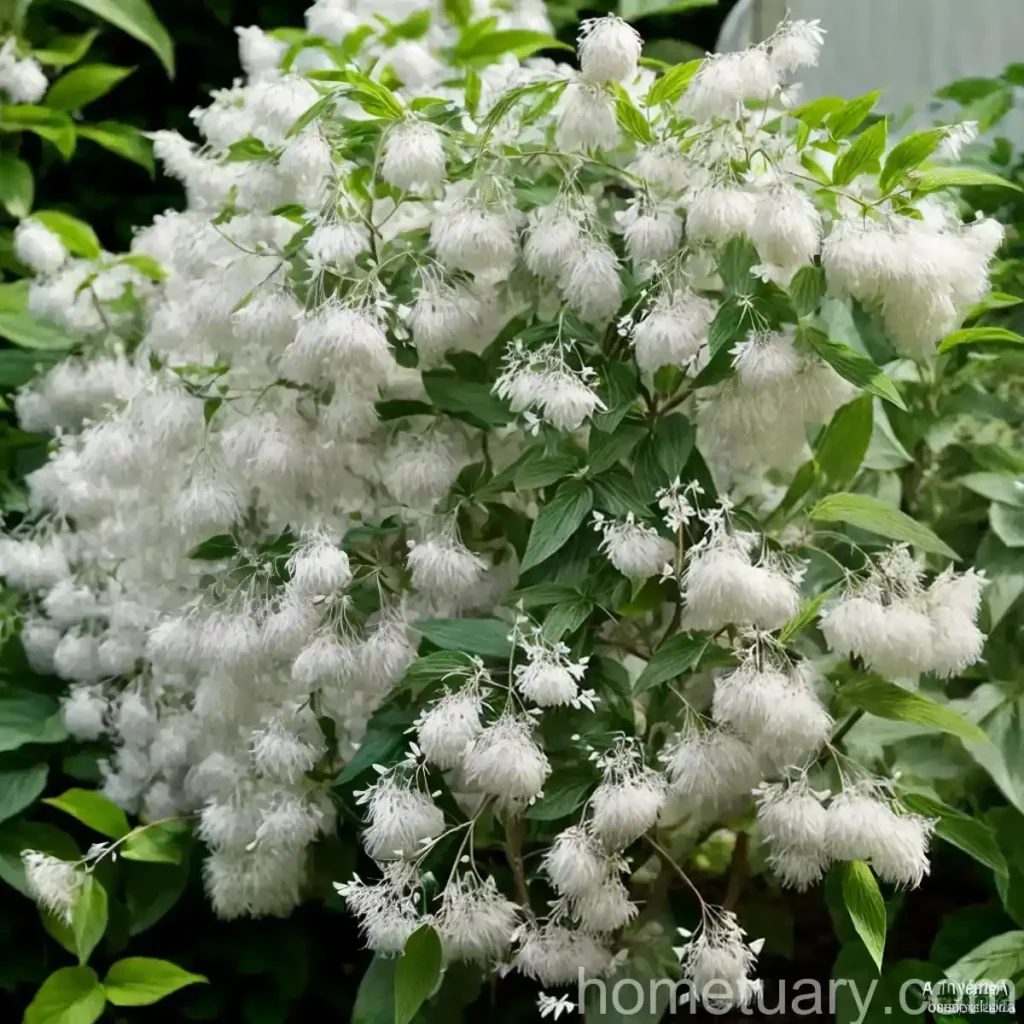The Fuzzy Deutzia (Deutzia scabra ‘Candidissima’): A Comprehensive Guide
The Fuzzy Deutzia, scientifically known as Deutzia scabra ‘Candidissima,’ is a beautiful ornamental shrub that belongs to the family Hydrangeaceae. This deciduous shrub is renowned for its elegant, cascading clusters of white flowers, which create a stunning visual impact in gardens and landscapes. In this comprehensive guide, we will delve into the various aspects of the fuzzy deutzia, including its cultural requirements, uses, maintenance, propagation, and common pests and diseases. Whether you are a seasoned gardener or a beginner plant enthusiast, this guide will provide you with valuable insights into cultivating and caring for the fuzzy deutzia.
What is the Fuzzy Deutzia (Deutzia scabra ‘Candidissima’)?
The Fuzzy Deutzia, Deutzia scabra ‘Candidissima,’ is a cultivar of Deutzia scabra, a species native to Japan and China. It is a medium-sized deciduous shrub that typically reaches a height of 5 to 8 feet (1.5 to 2.4 meters) and a spread of 4 to 6 feet (1.2 to 1.8 meters). The plant is characterized by its arching form, bearing ovate to lanceolate, finely toothed leaves that emerge in a soft, pale green color in spring, turning to a rich, dark green as the growing season progresses. However, the most striking feature of the fuzzy deutzia is its profusion of delicate, bell-shaped white flowers that adorn the branches in late spring to early summer, creating a breathtaking display.
Key Takeaways – Fuzzy Deutzia (Deutzia scabra ‘Candidissima’)
Before we explore the detailed aspects of the fuzzy deutzia, let’s take a quick look at its key takeaways:
- Scientific Name: Deutzia scabra ‘Candidissima’
- Cultural Requirements: Proper watering, sunlight, soil, and fertilizer are essential for its growth.
- Uses: It is extensively used in gardens and landscapes for its ornamental value.
- Maintenance: Regular pruning and suitable propagation methods are crucial for maintaining the health and vigor of the plant.
- Pest and Disease Management: Identifying common pests and diseases is important for effective control and prevention.
Now, let’s delve into the specific cultural, maintenance, and care requirements for cultivating and nurturing the fuzzy deutzia.
Culture
The successful cultivation of the fuzzy deutzia relies on understanding its specific cultural requirements, including water, sunlight, fertilizer, soil, and pruning. By providing the optimal conditions, you can ensure the healthy growth and abundant flowering of this exquisite shrub.
Water
Water Requirements: The fuzzy deutzia prefers consistently moist but well-drained soil. While it is important to ensure that the plant does not experience prolonged dry periods, it is equally crucial to avoid waterlogged conditions, as excessive moisture can lead to root rot and other issues. When establishing newly planted specimens, regular watering is essential to support root development. Once established, the plant generally exhibits good tolerance to moderate drought conditions.
Watering Frequency: During dry periods, water the fuzzy deutzia deeply approximately once or twice a week, allowing the soil to dry slightly between watering sessions. However, always adjust the watering frequency based on the specific environmental conditions and the moisture retention of the soil.
Sunlight
Sunlight Needs: The fuzzy deutzia thrives in full sun to partial shade. When provided with adequate sunlight, it ensures the development of healthy foliage and an abundance of flowers. However, it can also tolerate partial shade, making it a versatile addition to various garden settings. In regions with intense summer heat, providing some afternoon shade can be beneficial, as it helps prevent the foliage from scorching and protects the delicate flowers.
Optimal Sunlight Exposure: Aim to provide the plant with at least 4 to 6 hours of direct sunlight daily for best results. If planting in areas with intense sunlight, consider providing shade during the hottest part of the day to prevent stress and sunburn.
Fertilizer
Fertilization Needs: Providing appropriate nutrients is vital for promoting healthy growth and abundant flowering in the fuzzy deutzia. A balanced fertilizer formulated for flowering shrubs can provide the essential nutrients required for vigorous growth and prolific blooming.
Fertilizing Schedule: Apply a slow-release, balanced fertilizer in early spring before the onset of new growth. Follow the manufacturer’s recommendations regarding the application rate and frequency, and ensure even distribution around the plant’s root zone. Avoid over-fertilizing, as excessive nutrients can lead to rapid, weak growth and may reduce flowering.
Soil
Soil Preferences: The fuzzy deutzia thrives in rich, well-drained soil with a slightly acidic to neutral pH. Loamy, fertile soils with good structure support the development of a healthy root system and overall plant vigor. When planting or transplanting the fuzzy deutzia, amending the soil with organic matter such as compost or well-rotted manure can enhance soil fertility and improve moisture retention and drainage.
Soil Composition: Aim for a well-drained soil mix that provides good aeration without becoming excessively compacted. This ensures that the roots can access sufficient oxygen and nutrients, promoting robust growth and flowering.
Pruning
Pruning Techniques: Pruning plays a crucial role in maintaining the shape, vigor, and flowering potential of the fuzzy deutzia. Regular pruning also removes dead or diseased wood, improves air circulation, and encourages the growth of new shoots, contributing to a more abundant display of flowers.
Pruning Timing: After the flowering period, typically in late spring to early summer, is the ideal time to prune the fuzzy deutzia. This allows you to remove spent flowers and shape the shrub without impacting the next season’s flowering.
Key Pruning Steps:
1. Remove any dead, damaged, or diseased wood, cutting back to healthy growth points.
2. Thinning out congested growth to improve air circulation and light penetration.
3. Heading back the tips of the stems to promote branching and a more compact growth habit.
Propagation
Propagation Methods
-
Softwood Cuttings: Propagating the fuzzy deutzia from softwood cuttings is a reliable method to produce new plants. Take 4 to 6-inch (10 to 15 cm) long cuttings from the current season’s growth in late spring to early summer. Remove the lower leaves and dip the cut end in a rooting hormone before planting in a well-draining propagation mix. Provide bottom heat and maintain high humidity to encourage successful root formation.
-
Division: Established fuzzy deutzia plants can be propagated through division, particularly during the dormant season in late winter. Carefully dig up the plant and divide the root ball into sections, ensuring that each division has a good portion of roots and several healthy shoots. Replant the divisions in prepared soil, water well, and provide appropriate care to support their establishment.
-
Layering: Another method of propagation involves layering, where a low-growing branch is pegged down to the ground and covered with soil. Once roots have formed at the site of contact with the soil, the new plant can be separated from the parent plant and transplanted to a new location.
Propagation allows you to expand your collection of fuzzy deutzia plants, share them with fellow gardening enthusiasts, or regenerate new plants from an existing specimen.
Container Popularity
The fuzzy deutzia is well-suited for growing in containers, making it an excellent choice for patio gardens, small urban spaces, or as a focal point on a deck or balcony. When selecting a container for the fuzzy deutzia, choose one that has sufficient drainage holes to prevent waterlogged conditions. Ensure that the size of the container accommodates the plant’s mature size and provides enough space for the development of a healthy root system.
Container Care Tips
-
Soil Mix: Use a well-draining potting mix formulated for shrubs, or create a custom mix by combining regular potting soil with perlite or coarse sand to improve drainage.
-
Watering: Pay close attention to the moisture levels in the container, as the soil can dry out more quickly compared to plants in the ground. Water the fuzzy deutzia when the top inch of soil feels dry, and ensure that excess water can freely escape from the drainage holes.
-
Sunlight: Position the container in an area that receives adequate sunlight, as required by the fuzzy deutzia. If planting on a paved surface, consider placing the container on casters or saucers to allow for mobility and facilitate drainage.
-
Fertilization: Regularly feed container-grown fuzzy deutzia with a balanced fertilizer during the growing season, following the manufacturer’s recommendations for application frequency and rate.
Growing the fuzzy deutzia in containers offers the flexibility to showcase its beauty in various outdoor spaces while providing the opportunity for close monitoring and maintenance.
Common Diseases and Disease Diagnosis
While the fuzzy deutzia is generally resilient to many diseases, it is susceptible to certain issues under unfavorable conditions. Recognizing the symptoms and promptly addressing any potential diseases can help maintain the plant’s health and vitality.
Common Diseases
-
Powdery Mildew: This fungal disease can manifest as a powdery, white coating on the leaves, typically in humid conditions. To prevent powdery mildew, ensure good air circulation around the plant and avoid overhead watering. If detected, fungicidal treatments can effectively manage the issue.
-
Leaf Spot: Leaf spot diseases may occur, presenting as dark, discolored spots on the foliage. Improving air circulation and promptly removing any affected leaves can help prevent the spread of the disease.
-
Root Rot: Excessive soil moisture, especially in poorly drained soil, can lead to root rot. Proper watering practices and well-drained soil are essential in preventing this issue.
Disease Diagnosis
When diagnosing potential diseases, carefully examine the plant for any signs of unusual discoloration, distortion, or wilting. If you suspect a disease, consider consulting with a local horticultural extension service or a professional plant expert to accurately identify the issue and determine an appropriate course of action.
Common Pests
While relatively resilient, the fuzzy deutzia may encounter certain pests that can impact its growth and appearance. Monitoring the plant regularly allows for early detection and effective management of potential pest infestations.
Common Pests
Aphids: These small, soft-bodied insects may gather on the new growth and the undersides of leaves, causing damage by sucking sap from the plant. Insecticidal soap or neem oil applications can help control aphid populations without harming beneficial insects.
Scale Insects: Scale insects can infest the fuzzy deutzia, appearing as small, immobile bumps on the stems and leaves. Pruning out heavily infested areas and applying horticultural oil during the dormant season can aid in controlling scale populations.
Japanese Beetles: These voracious feeders may target the foliage of the fuzzy deutzia, causing extensive damage. Handpicking the beetles, using pheromone traps, or applying biological control measures can help manage Japanese beetle infestations.
Regular monitoring and prompt intervention can effectively mitigate the impact of common pests, preserving the health and visual appeal of the fuzzy deutzia.
Botanist’s Tips
To enhance your experience in growing and caring for the fuzzy deutzia, consider the following tips from botanists and experienced gardeners:
- Promote Air Circulation: Ensuring good air circulation around the plant helps prevent the development of fungal diseases and supports overall plant health.
- Provide Mulch: Applying a layer of organic mulch around the base of the fuzzy deutzia can help conserve soil moisture, suppress weed growth, and enrich the soil as it decomposes.
- Regular Inspection: Regularly inspect the plant for signs of diseases, pests, or nutrient deficiencies, taking timely action when necessary to maintain its well-being.
- Appropriate Spacing: When planting fuzzy deutzia shrubs, provide adequate spacing to allow for unhindered growth and proper air circulation between individual plants.
Incorporating these tips into your cultivation practices can contribute to the success and longevity of your fuzzy deutzia plants.
Fun Facts
- The fuzzy deutzia is also known by the common names “Pride of Rochester” and “Rochester Hydrangea.”
- Its Latin name, Deutzia, honors the Dutch botanist Johann van der Deutz.
- The fuzzy deutzia is an important source of nectar for pollinators, attracting bees, butterflies, and other beneficial insects to the garden.
Links to External Resources
For more information and resources on the fuzzy deutzia (Deutzia scabra ‘Candidissima’):
- Planting and Care Guide for Fuzzy Deutzia
- Tips for Successful Propagation of Deutzia scabra ‘Candidissima’
- Managing Pests and Diseases in Deutzia Plants
Conclusion
The fuzzy deutzia (Deutzia scabra ‘Candidissima’) is a splendid addition to gardens, landscapes, and container plantings, showcasing exceptional ornamental features and versatile cultural adaptability. By understanding its specific requirements for water, sunlight, soil, and maintenance, you can create an optimal environment for the growth and flourishing of this enchanting shrub. Additionally, identifying and managing potential pests and diseases ensures the preservation of its health and visual appeal.
Whether you are drawn to its abundant white flowers, elegant foliage, or its ecological significance in attracting pollinators, the fuzzy deutzia is a captivating plant that enriches outdoor spaces with its presence. By following the guidance provided in this comprehensive guide and integrating best practices, you can cultivate and nurture the fuzzy deutzia with confidence, fostering its beauty and vitality for years to come.
Remember to regularly observe and engage with your fuzzy deutzia, appreciating its seasonal changes and the abundance it brings to your botanical landscape. As you embark on your journey with this enchanting shrub, may your efforts be rewarded with a flourishing and visually stunning fuzzy deutzia display, becoming a testament to your dedication and care as a plant enthusiast and gardener.
Happy gardening, and may your fuzzy deutzia plants bloom with grace and abundance!
Author: [Your Name]
Date: [Current Date]















